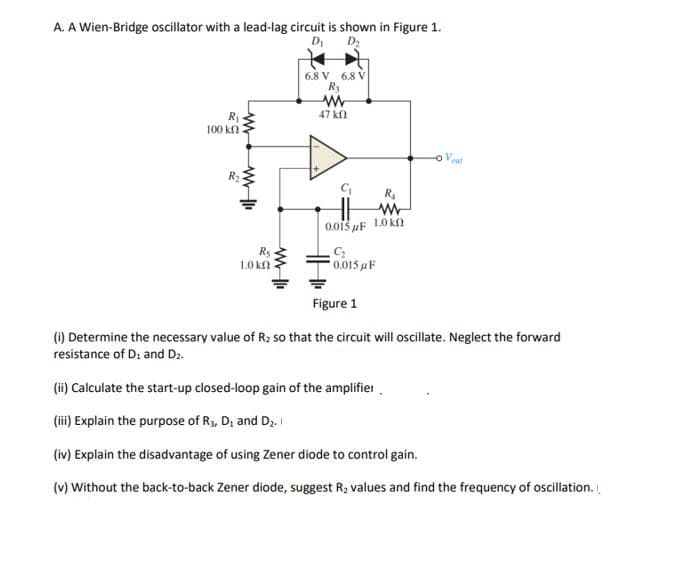A. A Wien-Bridge oscillator with a lead-lag circuit is shown in Figure 1. 6.8 V 6.8 V Ry 47 k 100 ki Vaut 0.0iš uF 1.0 k Rs 1.0 kn C 0.015 uF Figure 1 (1) Determine the necessary value of R2 so that the circuit will oscillate. Neglect the forward resistance of D: and D2. (ii) Calculate the start-up closed-loop gain of the amplifier. (iii) Explain the purpose of R, D; and Dz. (iv) Explain the disadvantage of using Zener diode to control gain. (v) Without the back-to-back Zener diode, suggest R, values and find the frequency of oscillation.
A. A Wien-Bridge oscillator with a lead-lag circuit is shown in Figure 1. 6.8 V 6.8 V Ry 47 k 100 ki Vaut 0.0iš uF 1.0 k Rs 1.0 kn C 0.015 uF Figure 1 (1) Determine the necessary value of R2 so that the circuit will oscillate. Neglect the forward resistance of D: and D2. (ii) Calculate the start-up closed-loop gain of the amplifier. (iii) Explain the purpose of R, D; and Dz. (iv) Explain the disadvantage of using Zener diode to control gain. (v) Without the back-to-back Zener diode, suggest R, values and find the frequency of oscillation.
Introductory Circuit Analysis (13th Edition)
13th Edition
ISBN:9780133923605
Author:Robert L. Boylestad
Publisher:Robert L. Boylestad
Chapter1: Introduction
Section: Chapter Questions
Problem 1P: Visit your local library (at school or home) and describe the extent to which it provides literature...
Related questions
Question

Transcribed Image Text:A. A Wien-Bridge oscillator with a lead-lag circuit is shown in Figure 1.
DI
D2
6.8 V 6.8 V
R3
47 kn
100 kΩ
o Vout
0.015 uF 1.0 k
Rs
1.0 kf
0.015 uF
Figure 1
(1) Determine the necessary value of R; so that the circuit will oscillate. Neglect the forward
resistance of D: and D2.
(ii) Calculate the start-up closed-loop gain of the amplifier.
(iii) Explain the purpose of R3, D; and Dz.
(iv) Explain the disadvantage of using Zener diode to control gain.
(v) Without the back-to-back Zener diode, suggest R2 values and find the frequency of oscillation.
Expert Solution
This question has been solved!
Explore an expertly crafted, step-by-step solution for a thorough understanding of key concepts.
Step by step
Solved in 5 steps with 3 images

Knowledge Booster
Learn more about
Need a deep-dive on the concept behind this application? Look no further. Learn more about this topic, electrical-engineering and related others by exploring similar questions and additional content below.Recommended textbooks for you

Introductory Circuit Analysis (13th Edition)
Electrical Engineering
ISBN:
9780133923605
Author:
Robert L. Boylestad
Publisher:
PEARSON

Delmar's Standard Textbook Of Electricity
Electrical Engineering
ISBN:
9781337900348
Author:
Stephen L. Herman
Publisher:
Cengage Learning

Programmable Logic Controllers
Electrical Engineering
ISBN:
9780073373843
Author:
Frank D. Petruzella
Publisher:
McGraw-Hill Education

Introductory Circuit Analysis (13th Edition)
Electrical Engineering
ISBN:
9780133923605
Author:
Robert L. Boylestad
Publisher:
PEARSON

Delmar's Standard Textbook Of Electricity
Electrical Engineering
ISBN:
9781337900348
Author:
Stephen L. Herman
Publisher:
Cengage Learning

Programmable Logic Controllers
Electrical Engineering
ISBN:
9780073373843
Author:
Frank D. Petruzella
Publisher:
McGraw-Hill Education

Fundamentals of Electric Circuits
Electrical Engineering
ISBN:
9780078028229
Author:
Charles K Alexander, Matthew Sadiku
Publisher:
McGraw-Hill Education

Electric Circuits. (11th Edition)
Electrical Engineering
ISBN:
9780134746968
Author:
James W. Nilsson, Susan Riedel
Publisher:
PEARSON

Engineering Electromagnetics
Electrical Engineering
ISBN:
9780078028151
Author:
Hayt, William H. (william Hart), Jr, BUCK, John A.
Publisher:
Mcgraw-hill Education,